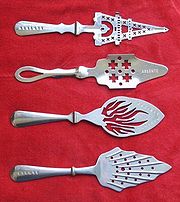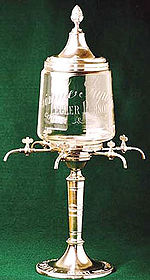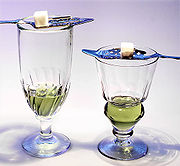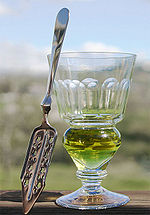
Absinthiana
Encyclopedia
Absinthiana are the accoutrements surrounding the drink absinthe
and its preparation ritual. Originally, absinthe was served in standard glasses and water was added from a simple carafe. But as its popularity grew so did the variety of implements used, such as specialty glasses and complex brouilleurs. In the period since absinthe's illegalization in the US antique dealers have seen dramatic increases in the prices of these artifacts there. Some absinthe spoons can fetch thousands of dollars.
Many 19th century companies used the elaborate barware to advertise their brands. Today many contemporary distilleries are also producing decorative branded barware for the same purpose.
 A perforated or slotted spoon
A perforated or slotted spoon
is used to dissolve a sugar
cube in a glass of absinthe
, usually to sweeten the drink and counteract its mild bitterness. The bowl of the spoon is normally flat, with a notch in the handle where it rests on the rim of the glass. Originating circa the 1860s, absinthe spoons were often stamped with brand names or logos as advertising, much like modern alcohol paraphernalia. Sometimes they were sold as tourist items; for example, some might be shaped like the Eiffel tower
, for example the spoon Eiffel Tower #7, which was made for the inauguration of the building in the year 1889.
 "Les Cuilleres" spoons, a less-common variation of the absinthe spoon, are similar to iced tea spoon
"Les Cuilleres" spoons, a less-common variation of the absinthe spoon, are similar to iced tea spoon
s. By contrast, these have a normal spoon
bowl and the sugar holder built into the handle.
 Adding ice cold water to absinthe is a common part of preparation: the addition of water causes a clouding, called the louche (called ouzo effect
Adding ice cold water to absinthe is a common part of preparation: the addition of water causes a clouding, called the louche (called ouzo effect
in other drinks).
It was sometimes considered an art form, and bars often had "professors of absinthe" who would show new drinkers how to properly add water one drop at a time.
is the most basic way to add water. As with other items, many have been found with brand names on them. The carafe is held high above the glass and water is delicately added, drop by drop.

 Absinthe was commonly served in normal bar-ware, but eventually specific glasses were popularized. These would commonly have a short thick stem and faceting to enhance the absinthe's appearance. Glasses were marked with a dose line, by either etching or a glass band, showing how much absinthe should be poured into them. The term 'reservoir glass' covers several styles of glassware with a small bulge at the bottom which marked the dose. They were the first type of glass made specifically for absinthe. A less common variation, called the bubble-reservoir glass, contained a defined bubble shaped reservoir.
Absinthe was commonly served in normal bar-ware, but eventually specific glasses were popularized. These would commonly have a short thick stem and faceting to enhance the absinthe's appearance. Glasses were marked with a dose line, by either etching or a glass band, showing how much absinthe should be poured into them. The term 'reservoir glass' covers several styles of glassware with a small bulge at the bottom which marked the dose. They were the first type of glass made specifically for absinthe. A less common variation, called the bubble-reservoir glass, contained a defined bubble shaped reservoir.
Absinthe
Absinthe is historically described as a distilled, highly alcoholic beverage. It is an anise-flavoured spirit derived from herbs, including the flowers and leaves of the herb Artemisia absinthium, commonly referred to as "grande wormwood", together with green anise and sweet fennel...
and its preparation ritual. Originally, absinthe was served in standard glasses and water was added from a simple carafe. But as its popularity grew so did the variety of implements used, such as specialty glasses and complex brouilleurs. In the period since absinthe's illegalization in the US antique dealers have seen dramatic increases in the prices of these artifacts there. Some absinthe spoons can fetch thousands of dollars.
Many 19th century companies used the elaborate barware to advertise their brands. Today many contemporary distilleries are also producing decorative branded barware for the same purpose.
Absinthe spoon

Slotted spoon
A slotted spoon is an implement used in food preparation. The term can be used to describe any spoon with slots, holes or other openings in the bowl of the spoon which let liquid pass through while preserving the larger solids on top...
is used to dissolve a sugar
Sugar
Sugar is a class of edible crystalline carbohydrates, mainly sucrose, lactose, and fructose, characterized by a sweet flavor.Sucrose in its refined form primarily comes from sugar cane and sugar beet...
cube in a glass of absinthe
Absinthe
Absinthe is historically described as a distilled, highly alcoholic beverage. It is an anise-flavoured spirit derived from herbs, including the flowers and leaves of the herb Artemisia absinthium, commonly referred to as "grande wormwood", together with green anise and sweet fennel...
, usually to sweeten the drink and counteract its mild bitterness. The bowl of the spoon is normally flat, with a notch in the handle where it rests on the rim of the glass. Originating circa the 1860s, absinthe spoons were often stamped with brand names or logos as advertising, much like modern alcohol paraphernalia. Sometimes they were sold as tourist items; for example, some might be shaped like the Eiffel tower
Eiffel Tower
The Eiffel Tower is a puddle iron lattice tower located on the Champ de Mars in Paris. Built in 1889, it has become both a global icon of France and one of the most recognizable structures in the world...
, for example the spoon Eiffel Tower #7, which was made for the inauguration of the building in the year 1889.

Iced tea spoon
An iced tea spoon, also called a soda spoon, is a thin spoon with a very long handle. It is used primarily in the United States, for stirring sugar or other sweeteners into iced tea, which is traditionally served in a tall glass. This is why the spoon has a very long handle.It is also commonly used...
s. By contrast, these have a normal spoon
Spoon
A spoon is a utensil consisting of a small shallow bowl, oval or round, at the end of a handle. A type of cutlery , especially as part of a place setting, it is used primarily for serving. Spoons are also used in food preparation to measure, mix, stir and toss ingredients...
bowl and the sugar holder built into the handle.
Grilles
Another sugar tool, the grille, lacks the overall spoon shape. Rather, it is generally a perforated metal saucer with 3 or more legs that hold it above the glass.Water drip

Ouzo effect
The ouzo effect is a phenomenon observed when water is added to ouzo and other anise-flavored liqueurs and spirits, such as pastis, raki, arak and absinthe, forming a milky oil-in-water microemulsion...
in other drinks).
It was sometimes considered an art form, and bars often had "professors of absinthe" who would show new drinkers how to properly add water one drop at a time.
Carafe
A water carafeCarafe
The carafe , is used for serving wine and other drinks. Unlike the related [decanter], carafes do not include stoppers.Coffee Pots included in coffee makers are also referred to as carafes....
is the most basic way to add water. As with other items, many have been found with brand names on them. The carafe is held high above the glass and water is delicately added, drop by drop.
Fountain
Fountains appeared in bars and bistros as absinthe gained popularity. Often a large glass container suspended above the table held between two and six spigots. It allowed a small party of drinkers to accurately prepare their absinthe all at once with a slow drip of cold water but did not require the painstaking concentration required by a carafe.Brouilleur
In some instances a device called a brouilleur was employed. A Brouilleur is a glass or metal bowl which sits on the absinthe glass and acts like a personal absinthe fountain. Ice and water are added to the bowl, which has a small hole at the bottom, and ice-cold water slowly drips through. Sugar can be added directly to the bowl, or in some cases to a built-in grille.Absinthe glass



